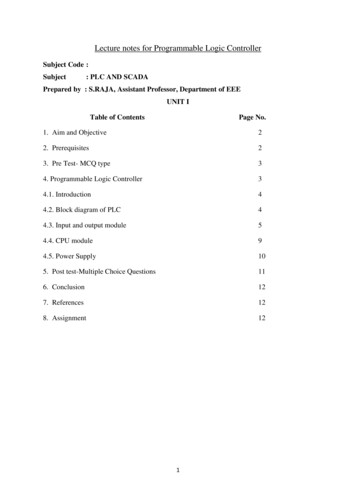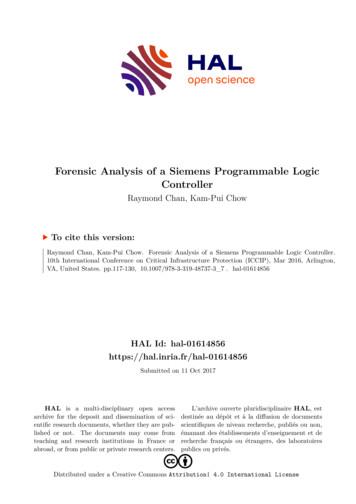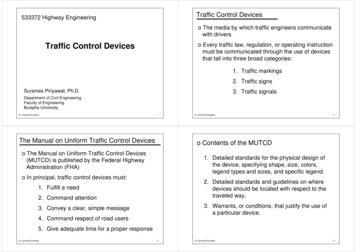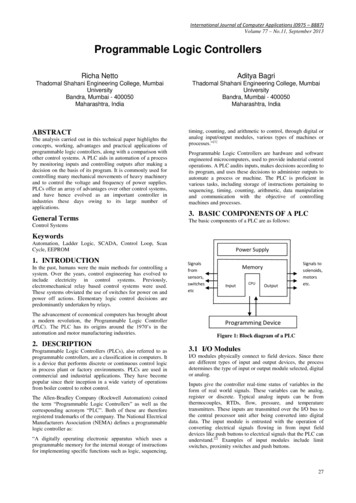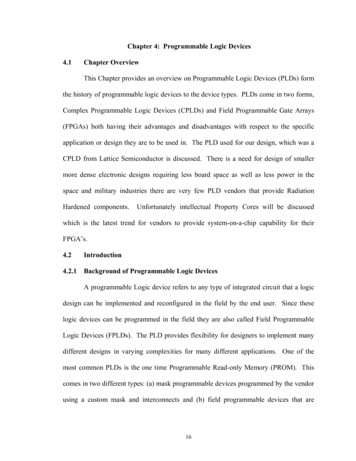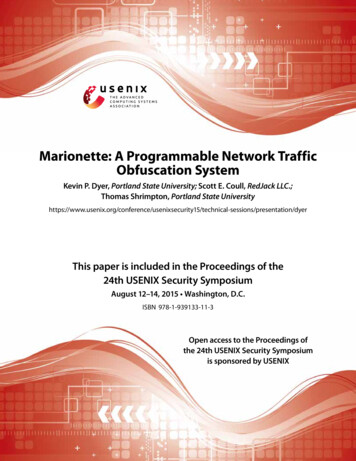
Transcription
Marionette: A Programmable Network TrafficObfuscation SystemKevin P. Dyer, Portland State University; Scott E. Coull, RedJack LLC.;Thomas Shrimpton, Portland State s paper is included in the Proceedings of the24th USENIX Security SymposiumAugust 12–14, 2015 Washington, D.C.ISBN 978-1-939133-11-3Open access to the Proceedings ofthe 24th USENIX Security Symposiumis sponsored by USENIX
Marionette: A Programmable Network-Traffic Obfuscation SystemKevin P. DyerPortland State Universitykdyer@cs.pdx.eduScott E. CoullRedJack, LLC.scott.coull@redjack.comAbstractRecently, a number of obfuscation systems have beendeveloped to aid in censorship circumvention scenarioswhere encrypted network traffic is filtered. In this paper, we present Marionette, the first programmable network traffic obfuscation system capable of simultaneously controlling encrypted traffic features at a varietyof levels, including ciphertext formats, stateful protocolsemantics, and statistical properties. The behavior of thesystem is directed by a powerful type of probabilistic automata and specified in a user-friendly domain-specificlanguage, which allows the user to easily adjust their obfuscation strategy to meet the unique needs of their network environment. In fact, the Marionette system is capable of emulating many existing obfuscation systems,and enables developers to explore a breadth of protocols and depth of traffic features that have, so far, beenunattainable. We evaluate Marionette through a seriesof case studies inspired by censor capabilities demonstrated in the real-world and research literature, including passive network monitors, stateful proxies, and activeprobing. The results of our experiments not only showthat Marionette provides outstanding flexibility and control over traffic features, but it is also capable of achieving throughput of up to 6.7Mbps when generating RFCcompliant cover traffic.1IntroductionMany countries have begun to view encrypted networkservices as a threat to the enforcement of informationcontrol and security policies. China [41] and Iran [7] arewell-known for their efforts to block encrypted serviceslike Tor [14], while other countries, such as the UnitedKingdom [18], have begun to express interest in blocking VPNs and anonymity systems. These discriminatoryrouting policies are empowered by analyzing traffic atboth the network layer (e.g. TCP/IP headers) and, moreUSENIX AssociationThomas ShrimptonPortland State Universityteshrim@cs.pdx.edurecently, the application layer. The latter looks for specific features of packet payloads that act as a signaturefor the application-layer protocol being transported.To combat application-layer filtering, several systems have been proposed to obfuscate packet payloads,and generally hide the true protocol being transported.Broadly speaking, these methods fall into one of threecategories: those that use encryption to fully randomize the messages sent (e.g., obfs4 [34], ScrambleSuit[42], Dust [40]); those that tunnel traffic using existing software artifacts (e.g., FreeWave [21], Facet [24]);and those that use encryption in combination with somelightweight ciphertext formatting to make the trafficmimic an allowed protocol (e.g., FTE [15], StegoTorus [38]). A few of these systems have been deployedand are currently used by more comprehensive circumvention systems, such as Lantern [1], uProxy [5], andTor [14].Despite the progress these obfuscation systems represent, each of them suffers from one or more shortcomings that severely limit their ability to adapt to new network environments or censorship strategies. Lightweightobfuscation methods based on randomization fail in situations where protocol whitelisting is applied, as in therecent Iranian elections [13]. Tunneling systems are intimately tied to a specific protocol that may not alwaysbe permitted within the restrictive network environment,such as the case of Skype in Ethiopia [27]. Protocolmimicry systems really only aim to mimic individualprotocol messages, and therefore fail to traverse proxiesthat enforce stateful protocol semantics (e.g., Squid [39]). Moreover, these systems can be quite brittle in the faceof proxies that alter protocol messages in transit (e.g., altering message headers can render FTE [15] inoperable).In any case, all of the systems are incapable of changingtheir target protocol or traffic features without heavy system re-engineering and redeployment of code. This is ahuge undertaking in censored networks.24th USENIX Security Symposium 367
Case StudyRegex-Based DPIProxy TraversalProtocol ComplianceTraffic AnalysisActive P, SSH, SMBHTTPFTP, POP3HTTPHTTP, FTP, SSHGoodput(Down/Up)68.2 / 68.2 Mbps5.8 / 0.41 Mbps6.6 / 6.7 Mbps0.45 / 0.32 Mbps6.6 / 6.7 MbpsFigure 1: Summary of Marionette case studies illustrating breadth of protocols and depth of feature control.The Marionette System. To address these shortcomings, we develop the Marionette system. Marionette is anetwork-traffic obfuscation system that empowers usersto rapidly explore a rich design space, without the needto deploy new code or re-design the underlying system.The conceptual foundation of Marionette is a powerful kind of probabilistic automaton, loosely inspired byprobabilistic input/output automata [45]. We use these toenforce (probabilistic) sequencing of individual ciphertext message types. Each transition between automatastates has an associated block of actions to perform,such as encrypting and formatting a message, samplingfrom a distribution, or spawning other automata to support hierarchical composition. By composing automata,we achieve even more comprehensive control over mimicked protocol behaviors (e.g., multiple dependent channels) and statistical features of traffic. In addition, theautomata admit distinguished error states, thereby providing an explicit mechanism for handling active attacks,such as censor-initiated “probing attacks.”At the level of individual ciphertext formats, we introduce another novel abstraction that supports fine-grainedcontrol. These template grammars are probabilisticcontext-free grammars (CFG) that compactly describesa language of templates for ciphertexts. Templates arestrings that contain placeholder tokens, marking the positions where information (e.g., encrypted data bytes,dates, content-length values) may be embedded by userspecified routines. Adopting a CFG to describe templateshas several benefits, including ease of deployment due totheir compact representation, ability to directly translategrammars from available RFCs, and use of the grammarin receiver-side parsing tasks.Everything is specified in a user-friendly domainspecific language (DSL), which enables rapid development and testing of new obfuscation strategies that arerobust and responsive to future network monitoring tools.To encourage adoption and use of Marionette it has beenmade available as free and open source software1 .Case studies. To display what is possible with Marionette, we provide several case studies that are inspiredby recent research literature and real-world censor capa1 https://github.com/kpdyer/marionette/368 24th USENIX Security Symposiumbilities. These are summarized in Figure 1. For one example, we show that Marionette can implement passivemode FTP by spawning multiple models that control interdependent TCP connections. For another, we use Marionette to mimic HTTP with enforced protocol semanticsand resilience to message alteration, thereby successfullytraversing HTTP proxies.Our studies show that Marionette is capable of implementing a range of application-layer protocols, fromHTTP to POP3, while also providing great depth in therange of traffic features it controls. Most importantly, itmaintains this flexibility without unduly sacrificing performance – achieving up to 6.7Mbps while still maintaining fully RFC-compliant protocol semantics. We alsoshow that the system performance is network-bound, anddirectly related to the constraints of the Marionette format being used.Security Considerations. While our case studies aremotivated by well-known types of adversaries, we avoida formal security analysis of our framework for two reasons. First, the security of the system is intimately tiedto the automata and template grammars specified by theuser, as well as how the chosen protocols and featuresinteract with the adversary. Second, any principled security analysis requires a generally accepted adversarialmodel. At the moment, the capabilities of adversaries inthis space are poorly understood, and there are no formalized security goals to target. With that said, we believeour case studies represent a diverse sample of adversariesknown to exist in practice, and hope that the flexibility ofour system allows it to adapt to new adversaries faced indeployment. More fully understanding the limits of oursystem, and the adversaries it may face, is left for futurework.2Related WorkIn this section, we discuss previous work in the area ofobfuscation and mimicry of application-layer protocols,as well as their common ancestry with network trafficgeneration research. The majority of systems aiming toavoid application-layer filtering are non-programmable,in the sense that they adopt one strategy at design-timeUSENIX Association
s2/3 [34]ScrambleSuit [42]obfs4 [34]Dust [40]SkypeMorph [26]StegoTorus [38]Freewave [21]Facet [24]SWEET [47]JumpBox [25]CensorSpoofer [36]CloudTransport [8]FTE ghThroughputFigure 2: A comparison of features across randomization, mimicry, tunneling, and programmable obfuscation systems. A “ " inthe first four columns mean the system is appropriate for the indicated type of monitoring device; in the last two, it means that thesystem has the listed property. Multi-layer control is the ability to control features beyond single, independent connections. Highthroughput systems are defined as any system capable of 1Mbps throughput. Both FTE and Marionette can trade throughput forcontrol over ciphertext traffic features.and it cannot be changed without a major overhaul ofthe system and subsequent re-deployment. The nonprogrammable systems can be further subdivided intothree categories based on their strategy: randomization,mimicry, or tunneling. A programmable system, however, allows for a variety of dynamically applied strategies, both randomization and mimicry-based, without theneed for changes to the underlying software. Figure 2presents a comparison of the available systems in eachcategory, and we discuss each of them below. For thoseinterested in a broader survey of circumvention and obfuscation technologies, we suggest recent work by Khattak et al. that discusses the space in greater detail [23].Network Traffic Generation.Before beginning ourdiscussion of obfuscation systems, it is important to pointout the connection that they share with the broader areaof network traffic generation. Most traffic generationsystems focus on simple replay of captured network sessions [33, 19], replay with limited levels of message content synthesis [12, 31], generation of traffic mixes withspecific statistical properties and static content [10, 37],or heavyweight emulation of user behavior with applications in virtualized environments [43]. As we willsee, many mimicry and tunneling systems share similarstrategies with the the key difference that they must alsotransport useful information to circumvent filtering.Randomization.For systems implementing the randomization approach, the primary goal is to remove allstatic fingerprints in the content and statistical characteristics of the connection, effectively making the traffic look like “nothing.” The obfs2 and obfs3 [34] protocols were the first to implement this approach by re-USENIX Associationencrypting standard Tor traffic with a stream cipher,thereby removing all indications of the underlying protocol from the content. Recently, improvements on thisapproach were proposed in the ScrambleSuit system [42]and obfs4 protocol [34], which implement similar content randomization, but also randomize the distributionof packet sizes and inter-arrival times to bypass both DPIand traffic analysis strategies implemented by the censor.The Dust system [40] also offers both content and statistical randomization, but does so on a per-packet, ratherthan per-connection basis. While these approaches provide fast and efficient obfuscation of the traffic, they onlywork in environments that block specific types of knownbad traffic (i.e., blacklists). In cases where a whiteliststrategy is used to allow known-good protocols, theserandomization approaches fail to bypass filtering, as wasdemonstrated during recent elections in Iran [13].Mimicry. Another popular approach is to mimic certain characteristics of popular protocols, such as HTTPor Skype, so that blocking traffic with those characteristics would result in significant collateral damage. Mimicry-based systems typically perform shallowmimicry of only a protocol’s messages or the statistical properties of a single connection. As an example,StegoTorus [38] embeds data into the headers and payloads of a fixed set of previously collected HTTP messages, using various steganographic techniques. However, this provides no mechanism to control statisticalproperties, beyond what replaying of the filled-in message templates achieves. SkypeMorph [26], on the otherhand, relies on the fact that Skype traffic is encrypted andfocuses primarily on replicating the statistical features ofpacket sizes and timing. Ideally, these mimicked pro-24th USENIX Security Symposium 369
tocols would easily blend into the background traffic ofthe network, however research has shown that mimickedprotocols can be distinguished from real versions of thesame protocol using protocol semantics, dependenciesamong connections, and error conditions [20, 17]. In addition, they incur sometimes significant amounts of overhead due to the constraints of the content or statisticalmimicry, which makes them much slower than randomization approaches.Tunneling.Like mimicry-based systems, tunnelingapproaches rely on potential collateral damage causedby blocking popular protocols to avoid filtering. However, these systems tunnel their data in the payload ofreal instances of the target protocols. The Freewave [21]system, for example, uses Skype’s voice channel to encode data, while Facet [24] uses the Skype video channel, SWEET [47] uses the body of email messages, andJumpBox [25] uses web browsers and live web servers.CensorSpoofer [36] also tunnels data over existing protocols, but uses a low-capacity email channel for upstreammessages and a high-capacity VoIP channel for downstream. CloudTransport [8] uses a slightly different approach by tunneling data over critical (and consequentlyunblockable) cloud storage services, like Amazon S3,rather than a particular protocol. The tunneling-basedsystems have the advantage of using real implementations of their target protocols that naturally replicate allprotocol semantics and other distinctive behaviors, andso they are much harder to distinguish. Even with this advantage, however, there are still cases where the tunneleddata causes tell-tale changes to the protocol’s behavior[17] or to the overall traffic mix through skewed bandwidth consumption. In general, tunneling approaches incur even more overhead than shallow mimicry systemssince they are limited by the (low) capacity of the tunneling protocols.Programmable Systems. Finally, programmable obfuscation systems combine the benefits of both randomization and mimicry-based systems by allowing the system to be configured to accommodate either strategy.Currently, the only system to implement programmableobfuscation is Format-Transforming Encryption (FTE)[15], which transforms encrypted data into a formatdictated by a regular expression provided by the user.The approach has been demonstrated to have both highthroughput and the ability to mimic a broad range ofapplication-layer protocols, including randomized content. Unfortunately, FTE only focuses on altering thecontent of the application-layer messages, and not statistical properties, protocol semantics, or other potentiallydistinguishing traffic features.370 24th USENIX Security SymposiumComparison with Marionette. Overall, each of thesesystems suffers from a common set of problems that weaddress with Marionette. For one, these systems, withthe exception of FTE, force the user to choose a single target protocol to mimic without regard to the user’sthroughput needs, network restrictions, and backgroundtraffic mix. Moreover, many of the systems focus on onlya fixed set of traffic features to control, usually only content and statical features of a single connection. In thosecases where tunneling is used, the overhead and latencyincurred often renders the channel virtually unusable formany common use cases, such as video streaming. Theprimary goal of Marionette, therefore, is not to developa system that implements a single obfuscation method todefeat all possible censor strategies, but instead to provide the user with the ability to choose the obfuscationmethod that best fits their use case in terms of breadth oftarget protocols, depth of controlled traffic features, andoverall network throughput.3Models and ActionsWe aim for a system that enables broad control overseveral traffic properties, not just those of individualapplication-layer protocol messages. These propertiesmay require that the system maintain some level ofstate about the interaction to enforce protocols semantics, or allow for non-deterministic behavior to matchdistributions of message size and timing. A natural approach to efficiently model this sort of stateful and nondeterministic system is a special type of probabilisticstate machine, which we find to be well-suited to ourneeds and flexible enough to support a wide range of design approaches.Marionette models.A Marionette model (or justmodel, for short) is a tuple M (Q, Qnrm , Qerr , C, ).The state set Q Qnrm Qerr , where Qnrm is the set ofnormal states, Qerr is the set of error states, and Qnrm Qerr . We assume that Qnrm contains a distinguishedstart state, and that at least one of Qnrm , Qerr containsa distinguished finish state. The set C is the set of actions, which are (potentially) randomized algorithms. Astring B f1 f2 · · · fn C is called an action-block,and it defines a sequence of actions. Finally, is a transition relation Q C (dist(Qnrm ) ) P(Qerr )where dist(X) the set of distributions over a set X, andP(X) is the powerset of X. The roles of Qnrm and Qerrwill be made clear shortly.A tuple (s, B, (µnrm , S)) is interpreted as follows. When M is in state s, the action-block Bmay be executed and, upon completion, one samples astate s nrm Qnrm (according to distribution µnrm USENIX Association
dist(Qnrm )). If the action-block fails, then an errorstate is chosen non-deterministically from S. Therefore,{s nrm } S is the set of valid next states, and in thisway our models have both proper probabilistic and nondeterministic choice, as in probabilistic input/output automata [45]. When (s, B, (µnrm , )) , then onlytransitions to states in Qnrm are possible, and similarlyfor (s, B, ( , S)) with transitions to states in Qerr .In practice, normal states will be states of the modelthat are reached under normal, correct operation of thesystem. Error states are reached with the system detectsan operational error, which may or may not be caused byan active adversary. For us, it will typically be the casethat the results of the action-block B determine whetheror not the system is operating normally or is in error, thuswhich of the possible next states is correct.Discussion.Marionette models support a broad variety of uses. One is to capture the intended state of achannel between two communicating parties (i.e., whatmessage the channel should be holding at a given point intime). Such a model serves at least two related purposes.First, it serves to drive the implementation of proceduresfor either side of the channel. Second, it describes what apassive adversary would see (given implementations thatrealize the model), and gives the communicating partiessome defense against active adversaries. The model tellsa receiving party exactly what types of messages may bereceived next; receiving any other type of message (i.e.,observing an invalid next channel state) provides a signalto commence error handling, or defensive measures.Consider the partial model in Figure 3 for an exchangeof ciphertexts that mimic various types of HTTP messages. The states of this model represent effective statesof the shared channel (i.e., what message type is to appear next on the channel). Let us refer to the first-senderas the client, and the first-receiver as the server. In thebeginning, both client and server are in the start state.The client moves to state http get js with probability0.25, state http get png with probability 0.7, and stateNONE with probability 0.05. In transitioning to anyof these states, the empty action-block is executed (denoted by ε), meaning there are no actions on the transition. Note that, at this point, the server knows onlythe set {http get js, http get png, NONE} of valid statesand the probabilities with which they are selected.Say that the client moves to state http get png, thusthe message that should be placed on the channel is tobe of the http get png type. The action-block Bget pnggives the set of actions to be carried out in order to affectthis. We have annotated the actions with “c:” and “s:”to make it clear which meant to be executed by the clientand which are meant to be executed by the server, respec-USENIX AssociationBget js , 0.85http get jsBget js , 0.15ε , .25Bget png , 0.1ε , .7STARThttp ok jshttp get pngBok jsB404http 404Bget png , 0.9Bok pnghttp ok pngε , .05Bget pngBget pngNONEERROR(parse fail)Berr-parse(error-handling paths)ε , 1.0ERROR(decrypt fail)Berr-decrpytBget png:c: X encrypt(M,http get png)c: Y postprocess(X,http get png)s: X parse(Y,http get png)s: M decrypt(X,http get png)Figure 3: A partial graphical representation of a Marionettemodel for an HTTP exchange. (Transitions between http get jsand error states dropped to avoid clutter.) The text discussespaths marked with bold arrows; normal states on these are blue,error states are orange.tively. The client is to encrypt a message M using the parameters associated to the handle http get png, and thenapply any necessary post-processing in order to producethe (ciphertext) message Y for sending. The server, ismeant to parse the received Y (e.g. to undo whateverwas done by the post-processing), and then to decryptthe result.If parsing and decrypting succeed at the server, thenit knows that the state selected by the client washttp get png and, hence, that it should enter http 404with probability 0.1, or http ok png with probability0.9. If parsing fails at the server (i.e. the server actionparse(Y,http get png) in action block Bget png fails) thenthe server must enter state ERROR (parse fail). If parsingsucceeds but decryption fails (i.e., the server action decrypt(X,http get png) in action block Bget png fails) thenthe server must enter state ERROR (decrypt fail). At thispoint, it is the client who must keep alive a front of potential next states, namely the four just mentioned (errorstates are shaded orange in the figure). Whichever statethe server chooses, the associated action-block is executed and progress through the model continues until itreaches the specified finish state.Models provide a useful design abstraction for specifying allowable sequencings of ciphertext messages, aswell as the particular actions that the communicating parties should realize in moving from message to message(e.g., encrypt or decrypt according to a particular ciphertext format). In practice, we do not expect sender and24th USENIX Security Symposium 371
receiver instantiations of a given model will be identical.For example, probabilistic or nondeterministic choicesmade by the sender-side instantiation of a model (i.e.,which transition was just followed) will need to be “determinized” by the receiver-side instantiation. This determinization process may need mechanisms to handleambiguity. In Section 7 we will consider concrete specifications of models.4Templates and Template GrammarsIn an effort to allow fined-grained control over the format of individual ciphertexts on the wire, we introducethe ideas of ciphertext-format templates, and grammarsfor creating them. Templates are, essentially, partiallyspecified ciphertext strings. The unspecified portions aremarked by special placeholders, and each placeholderwill ultimately be replaced by an appropriate string, (e.g.,a string representing a date, a hexadecimal value representing a color, a URL of a certain depth). To compactlyrepresent a large set of these templates, we will use aprobabilistic context-free grammar. Typically, a grammar will create templates sharing a common motif, suchas HTTP request messages or CSS files.Template Grammars.A template grammar G (V, Σ, R, S, p) is a probabilisitic CFG, and we refer tostrings T L(G) as templates. The set V is the set ofnon-terminals, and S V is the starting non-terminal.The set Σ Σ P consists of two disjoint sets of symbols: Σ are the base terminals, and P is a set of placeholder terminals (or just placeholders). Collectively, werefer to Σ as template terminals. The set of rules R consists of pairs (v, β) V (V Σ) , and we will sometimes adopt the standard notation v β for these. Finally, the mapping p : R (0, 1] associates to each rulea probability. We require that the sum of values p(v, ·)for a fixed v V and any second component is equalto one. For simplicity, we have assumed all probabilities are non-zero. The mapping p supports a methodfor sampling templates from L(G). Namely, beginningwith S, carry out a leftmost derivation and sample amongthe possible productions for a given rule according to thespecified distribution.Template grammars produce templates, but it is nottemplates that we place on the wire. Instead, a template T serves to define a set of strings in Σ , all of whichshare the same template-enforced structure. To producethese strings, each placeholder γ P has associated toit a handler. Formally, a handler is a algorithm that takesas inputs a template T Σ and (optionally) a bit stringc {0, 1} , and outputs a string in Σ or the distinguished symbol , which denotes error. A handler for γ372 24th USENIX Security Symposiumscans T and, upon reading γ, computes a string in s Σ and replaces γ with s. The handler halts upon reachingthe end of T , and returns the new string T that is T butwill all occurrences of γ replaced. If a placeholder γ isto be replaced with a string from a particular set (say adictionary of fixed strings, or an element of a regular language described by some regular expression), we assumethe restrictions are built into the handler.As an example, consider the following (overly simple)production rules that could be a subset of a context-freegrammar for HTTP requests/responses.header date prop : date val \r\ndate prop Datecookie propdate valcookie val cookie prop : cookie val \r\n Cookie γcookie γdateTo handle our placeholders γdate and γcookie ,we might replace the former with the result ofFTE[”(Jan Feb .”)], and the latter with the result ofrunning FTE[”([a-zA-Z.)”]. In this example our FTEbased handlers are responsible for replacing the placeholder with a ciphertext that is in the language of its input regular expression. To recover the data we parse thestring according to the the template grammar rules, processing terminals in the resultant parse tree that correspond to placeholders.5System ArchitectureIn Section 3 we described how a Marionette model canbe used to capture stateful and probabilistic communications between two parties. The notion of abstract actions(and action-blocks) gives us a way to use models generatively, too. In this section, we give a high-level description of an architecture that supports this use, so that wemay transport arbitrary datastreams via ciphertexts thatadhere to our models. We will discuss certain aspectsof our design in detail in subsequent sections. Figure ?provides a diagram of this client-server proxy architecture. In addition to models, this architecture consists ofthe following components: The client-side driver runs the main event loop, instantiates models (from a model specification file,see Section 6.3), and destructs them when they havereached the end of their execution. The complimentary receiver-side broker is responsible for listeningto incoming connections and constructing and destructing models. Plugins are the mechanism that allow user-specifiedactions to be invoked in action-blocks. We discussplugins in greater detail in Section 6.2.USENIX Association
atscreate new model/channel?marionette servermarionette clientFigure 4: A high-level diagram of the Marionette client-server architecture and its major components for the client-server streamof communications in the Marionette system. The client-side multiplexer is an interface that allows plugins to serialize incoming datastreams intobitstrings of precise lengths, to be encoded intomessages via plugins. The receiver-side demultiplexer parses and deserializes streams of cells torecover the underlying datas
Many countries have begun to view encrypted network services as a threat to the enforcement of information control and security policies. China [41] and Iran [7] are well-known for their efforts to block encrypted services like Tor [14], while other countries, such as the United Kingdom [18], have begun to express interest in block-
